To maximize your ice fishing success, focus on these proven strategies: drill multiple holes in a grid pattern to cover more area, use a reliable fish finder to locate schools and structure, match your bait size to target species, and perfect your jigging technique with a lift-fall-pause rhythm. You'll also want to verify safe ice conditions (minimum 4 inches), monitor weather patterns affecting fish behavior, and set up near key structural elements like weed beds and drop-offs. Combine tip-ups with active jigging, keep your bait presentation natural, and don't forget to check different depths systematically. These fundamental tactics will help launch your winter fishing adventure to the next level.
Understanding Ice Thickness Safety
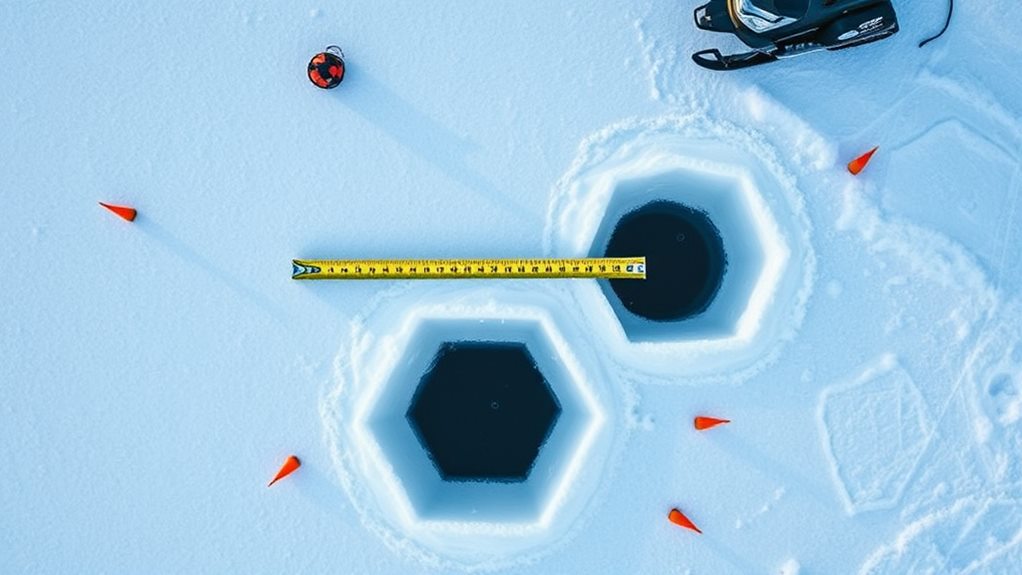
When venturing onto frozen lakes for ice fishing, understanding proper ice thickness is absolutely critical for your safety. Before you even think about setting up your fishing spot, you'll need to check the ice conditions thoroughly using an auger or chisel – never rely on secondhand reports about ice thickness.
For safe ice fishing on foot, you'll want a minimum recommended ice thickness of 4 inches of clear black ice. If you're planning to bring your snowmobile or ATV, wait until you've got 5-7 inches of solid ice. Heading out in your car? Make sure there's at least 8-12 inches, while full-sized trucks require 14-16 inches of ice thickness.
As you walk onto the lake, use a spud bar to continuously test the ice ahead of you. Keep an eye out for signs of weak ice, including discoloration, cracks, holes, or areas with flowing water – these are danger zones you'll want to avoid.
Remember that ice conditions can change rapidly, even within the same day, so don't assume an area that was safe earlier will remain so. Your safety depends on staying vigilant and checking ice conditions frequently.
Selecting Prime Fishing Locations
Beyond the basics of ice safety, choosing the right fishing spot can make or break your ice fishing success. Popular destinations like Lake of the Woods in Minnesota and Lake Winnebago in Wisconsin offer excellent opportunities to find diverse fish species, making them ideal for your next ice fishing trip.
Additionally, utilizing high-quality ice fishing tip-ups can greatly enhance your chances of catching more fish. When you're searching for prime fishing locations, focus on structural elements that attract fish. You'll want to look for rock piles, weed beds, and drop-offs where fish naturally gather for shelter and food.
Early in the season, target shallow water areas where fish are still actively feeding from their pre-freeze patterns. As winter progresses, you'll need to adjust your strategy and move to deeper waters.
To maximize your chances of success, use sonar technology to locate schools of bait fish and invertebrates. These smaller creatures are reliable indicators of productive fishing spots.
Don't forget to mark your previous drilling holes – not only is this a safety measure, but these spots might still hold fish due to their feeding memory. Remember, finding the fish is half the battle, so take time to scout locations before setting up your fishing tackle.
Essential Gear Setup
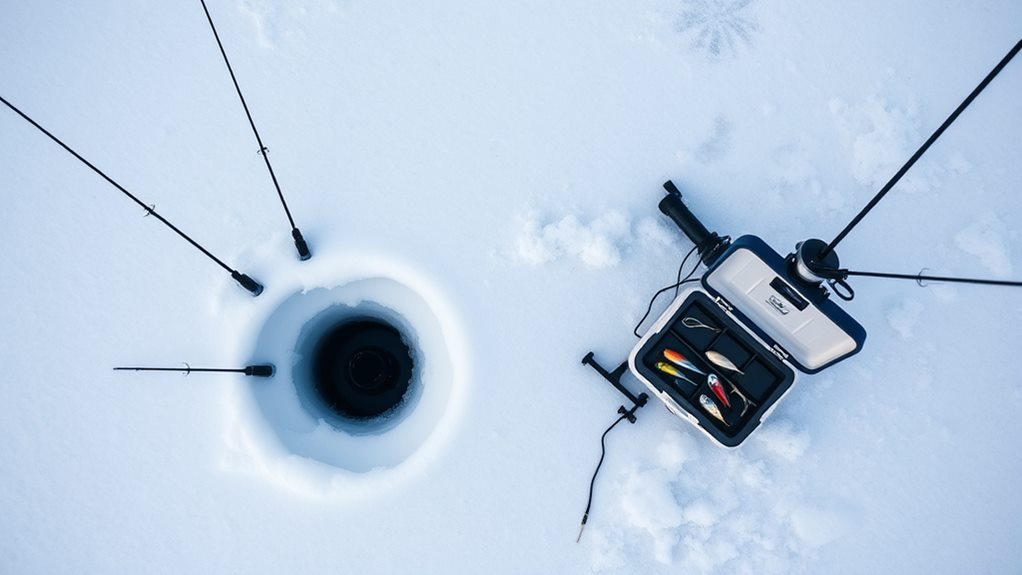
A successful ice fishing expedition depends heavily on having the right gear setup. You'll need to start with a reliable ice auger to create your fishing holes, and while hand augers are budget-friendly at $50-$100, power augers offer more convenience if you're willing to invest around $350.
Your ice rod and reel combos should be specifically designed for ice fishing, featuring shorter, sensitive jigging rods paired with spring bobbers for ideal bite detection in cold conditions.
To maximize your chances of success, consider adding a portable fish finder to your arsenal, as it'll help you locate fish and monitor their activity beneath the ice.
Don't forget about transportation – ice sleds are vital for hauling your equipment across frozen lakes, making fishing a lot more manageable when you're loaded with gear.
Most importantly, never skimp on safety gear. Pack ice picks, flotation suits, and a first-aid kit every time you head out.
While the right equipment might seem like a significant investment, it's important for both your safety and success on the ice.
Mastering Jigging Techniques
Once you've got your gear properly set up, it's time to master the art of ice jigging. The key to success lies in perfecting a lift-fall-pause sequence with your ice fishing rod, while experimenting with different speeds and rhythms to entice fish.
You'll want to pair sensitive rods with spring bobbers to detect even the slightest nibbles that might otherwise go unnoticed.
Consider these vital jigging techniques to enhance your catch rate:
- Mix aggressive jigging movements to spark fish curiosity with strategic pauses to enhance hook sets
- Alternate between various fishing lures like vertical jigging spoons, darters, and lipless crankbaits
- Add fish attractants and scent balls to draw more fish to your presentation
When you're out on the ice, remember that different species respond to different approaches. Start with moderate jigging motions and adjust based on the fish's reaction.
If you're not getting bites, don't hesitate to switch up your technique or try a different lure. The most successful ice anglers know that versatility is critical – what works one day mightn't work the next, so keep experimenting until you find what triggers the bite.
Effective Bait Presentation
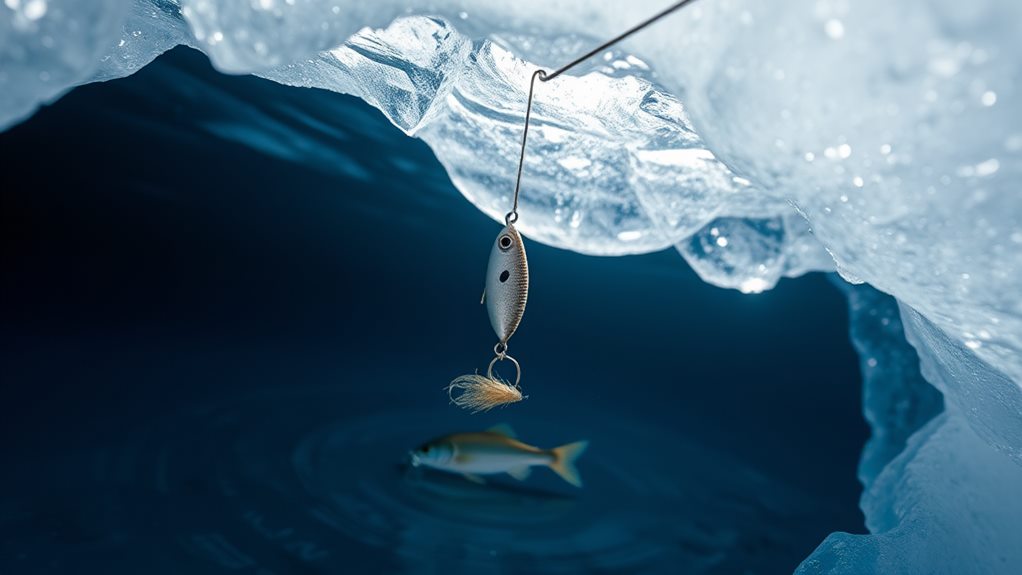
Successful ice fishing hinges on proper bait presentation, which combines the right bait size, positioning, and movement to entice your target species. When selecting your bait, match the size to your quarry – smaller offerings work best for panfish, while larger baits attract predators like pike and walleye.
For effective bait presentation, you'll want to master both jigs and tip-ups. Rig your jigs with live bait or soft plastics, like tubes and minnow imitations, to appeal to various species. When using tip-ups, position live minnows near the bottom with a sinker, or try quick-strike rigs with dead bait for trophy pike.
Your jigging technique can make all the difference. Work your bait in a lift-fall-pause pattern, adjusting the speed and rhythm until you find what works. Remember, aggressive jigging often draws attention, but those pauses are essential for hook sets.
Don't forget to enhance your presentation with fish attractants. These handy additions release scent and bubbles that draw fish to your bait, especially effective in cold water when fish might need extra motivation to bite.
Reading Fish Behavior Patterns
Understanding fish behavior patterns builds on your bait presentation skills and can mean the difference between a productive or empty day on the ice. As the ice fishing season progresses, you'll notice that water temperature markedly affects fish behavior, requiring you to adjust your fishing techniques accordingly.
During colder conditions, fish become less aggressive and need a more subtle approach to entice them to bite.
- Watch for concentrations of baitfish, as predatory fish like walleye and pike will typically be nearby, following their food source.
- Monitor weather conditions, particularly on overcast days when fish tend to feed more actively compared to bright, sunny periods.
- Track seasonal changes throughout the winter, as fish locations shift from shallow to deeper waters.
You'll want to pay attention to where fish are congregating during different parts of the season. Early ice often finds them in shallower waters where they've been feeding, while mid-winter typically pushes them deeper.
Understanding these feeding behavior patterns helps you locate fish more effectively, especially when you consider factors like spawning cycles and the presence of their preferred prey.
Multiple Hole Strategy
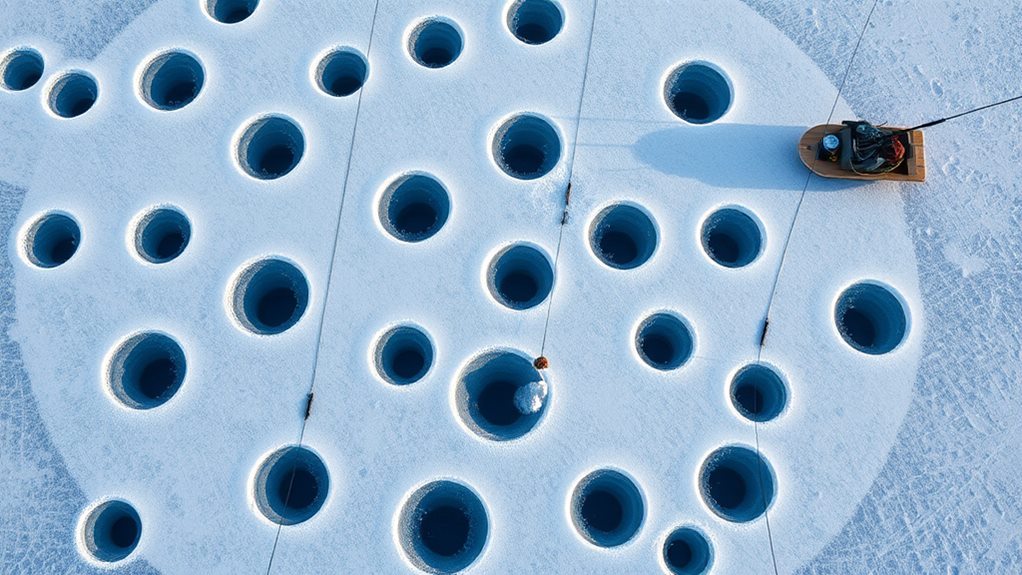
The multiple hole strategy gives you a tactical advantage when ice fishing by expanding your coverage area and improving your chances of finding active fish. By drilling holes in a grid or zigzag pattern, you'll create a systematic approach to locate fish across different areas of the lake. When you combine ice tip-ups with jigging techniques, you're able to monitor multiple holes simultaneously, greatly increasing your odds of success.
| Strategy Component | Morning | Afternoon | Evening |
|---|---|---|---|
| Hole Pattern | Grid | Zigzag | Grid |
| Depth Testing | 5-15 ft | 15-25 ft | 10-20 ft |
| Rotation Time | 15 min | 20 min | 15 min |
| Monitoring Method | Sonar | Visual | Both |
Using sonar technology helps you quickly identify which holes are most productive, allowing you to make smart decisions about where to focus your efforts. Don't forget to experiment with different depths across your holes, as fish often change their preferred depth throughout the day. If you're not getting any bites, rotate between holes every 15-20 minutes – fish activity can vary greatly between locations, and staying mobile is key to finding the most active spots.
Temperature and Weather Impact
During ice fishing season, weather patterns and temperature fluctuations dramatically influence your chances of success on the ice. You'll want to pay close attention to barometric pressure changes, as fish activity tends to peak before cold fronts and decrease after storms pass through. Understanding these patterns can help you plan your trips more effectively.
- Monitor temperature fluctuations closely, as warmer winter days can trigger aggressive feeding behavior, while extended cold spells might leave fish sluggish.
- Watch for cloud cover, which creates ideal fishing conditions by reducing light penetration and making fish feel more secure.
- Check wind direction to locate productive spots, as fish often seek shelter from the wind on the leeward side of structures.
Safety and success go hand in hand when you're dealing with changing weather conditions. Always verify ice thickness before heading out, especially during warming trends that can weaken the ice.
Position yourself strategically by considering wind direction and finding areas where fish naturally congregate for shelter. Remember, cloudy days aren't just comfortable for you – they're often prime fishing conditions that can lead to more catches.
Depth Finding Methods
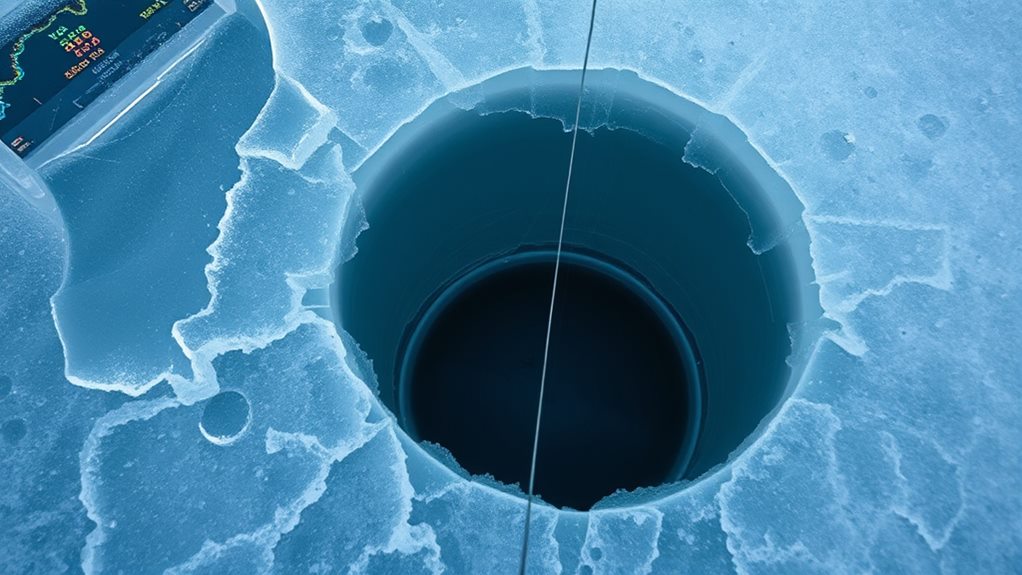
After monitoring weather conditions, your next challenge is locating fish at the right depth. The key to successful ice fishing lies in your ability to systematically explore different water depths and understand where fish are actively feeding.
Start by drilling multiple fishing holes at varying depths, typically between 3 and 20 feet. You'll want to use a portable fish finder to map out the underwater terrain and identify promising spots. This technology's not just a luxury anymore – it's a crucial tool that'll help you spot both your target species and the bait fish they're chasing.
Remember that bait depth isn't a one-size-fits-all solution. Fish location changes throughout the season:
- Early ice: Look closer to the bottom
- Mid-winter: Focus on deeper water
- Active fish: May suspend at varying depths
Your success depends on being methodical with your jigging techniques while paying attention to water conditions.
Watch your fish finder for signs of bait fish and invertebrates – they're usually reliable indicators of where predatory fish are hanging out. Keep adjusting your approach until you establish a pattern of strikes, and don't hesitate to switch depths if the action slows.
Targeting Specific Fish Species
Since different fish species exhibit unique behaviors and habitat preferences, you'll need to adjust your tactics accordingly to maximize success on the ice.
When targeting specific fish species, it's crucial to understand their preferred depths and habitats. Crappies, for instance, are typically found in shallow waters near structure during low-light conditions, while lake trout prefer much deeper waters with temperature gradients.
- Yellow perch and walleye often share similar depth ranges (10-20 feet), but perch favor weed beds while walleye are more active during low-light periods.
- Northern pike are the shallow-water predators, hanging around weedy areas where you can tempt them with larger baits on quick-strike rigs.
- Lake trout require the deepest presentation, sometimes as deep as 60 feet, where slow, steady retrieves with heavy jigs work best.
To improve your catch rate, match your presentation to each species' preferences.
You'll want to use smaller jigs for crappies and perch, medium-sized lures for walleye, and larger presentations for northern pike.
Remember to adjust your depth and bait size based on the species you're pursuing, and you'll greatly enhance your chances of success.
Frequently Asked Questions
How Do I Attract More Fish for Ice Fishing?
You'll attract more fish by using natural attractants, switching to horizontal jigs, covering holes with ice shavings, keeping bait near the bottom, and trying different jigging patterns with lifts and pauses.
What Is the Trick to Ice Fishing?
You'll succeed at ice fishing by drilling holes near structure, using both tip-ups and jigging rods, selecting the right bait size, and staying mobile. Don't forget to match your jigging cadence to fish activity.
How Do I Attract More Fish for Fishing?
You'll attract more fish by using natural attractants that release scents and bubbles. Try different jigging movements, position your bait strategically, and use sonar to locate schools of fish and their food sources.
What Is the Best Way to Catch a Lot of Fish?
You'll catch more fish by drilling holes in a pattern, using multiple lines, and varying your jigging techniques. Target areas near structures, experiment with different baits, and stay patient while monitoring your spots.
Final Thoughts
You're now equipped with proven strategies to improve your ice fishing success. By combining proper safety measures, strategic hole placement, and effective jigging techniques, you'll maximize your chances of landing more fish. Remember, successful ice fishing isn't just about the catch – it's about adapting to conditions, staying comfortable, and making smart decisions on the ice. Put these methods into practice, and you'll see the difference in your next winter fishing adventure.




